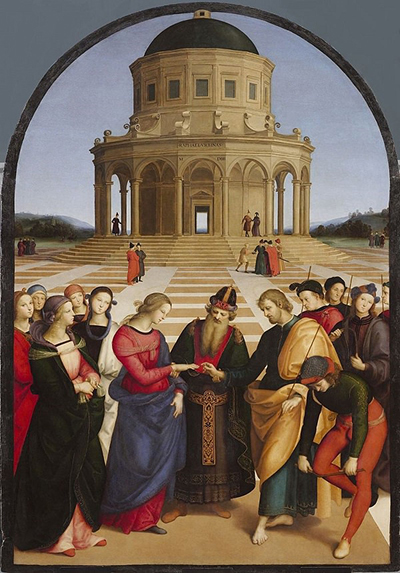Raphael painted Marriage of the Virgin in 1504. This was constructed as an oil on rounded canvas and measures 170 centimetres by 118 centimetres. Today this masterpiece is housed in the Pinacoteca di Brera of Milan in Italy.
The Marriage of the Virgin clearly shows the marriage of Saint Joseph and the Virgin Mary. The painting was commissioned by the Church at Citta di Castello in Italy. The painting is magnificent in its use of imagery, bright colours and sheer scope.
As a Rennaisance artist, Rapheal was able to depict perspective beautifully, and this is clearly evident in The Marriage of the Virgin. Within the background of the painting, we can see the Italian temple that is round and imposing.
On the temple walls have been painted doors, and it is clear that the temple is open. Through one of the open doors we are able to glimpse the image of bright blue sky and the luscious hills below. The temple has been painted at the uppermost part of the canvas.
Towards the middle of the canvas is the red stone plaza, and it is from this plaza, that Raphael has painted a series of steps that lead upwards towards the temple. Milling about the plaza are various people dressed in typical Renaissance clothes, and it is amusing to note that they are unaware of the significance of the marriage that is taking place.
The foreground is dominated by the wedding party and we observe the priest holding the hand of both the bride and groom, in preparing for the placement of the wedding ring.
Behind the Virgin Mary stand a group of women, who are perhaps her kinswoman, although their identity is unknown. We also observe a small girl to the left of the image who is wearing a red dress.
She is looking directly at the observer. Saint Joseph also has a group of men standing behind him, and again their identities are unknown. What is quite captivating, is that all the man carry rods, but it is only Joseph's rod that has broken and has blossomed with flowers.
The Virgin Mary wears a red dress, which is perhaps why the little girl is also wearing red. Her hair is adorned with a thin veil and she also wears a vibrant blue cloak. Joseph appears to be wearing a plain cassock, with an elaborate cloak draped around his shoulders.




